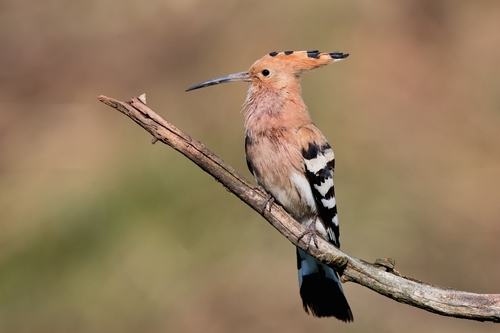
Eurasian Hoopoe
The Eurasian Hoopoe (Upupa epops) is a distinctive and striking bird, easily recognized by its long, curved bill, prominent crest, and striking black-and-white striped wings. Found across Europe, Asia, and Africa, this bird plays a significant role in many ecosystems as an insectivore, helping to control insect populations. Culturally, the Hoopoe has been featured in mythology and folklore across various civilizations, often symbolizing virtue or, in some cases, thievery. Its unique appearance and distinctive 'oop-oop-oop' call make it a memorable species for birdwatchers and nature enthusiasts.
25-32 cm
Length
44-48 cm
Wingspan
Least Concern
Conservation Status
Distribution
The Eurasian Hoopoe has a broad distribution, ranging across Europe, Asia, and Africa. It is also found in parts of Madagascar. Migratory populations breed in Europe and Asia and winter in Africa and southern Asia. They have a wide altitudinal range, from sea level to mountainous regions.
Lifespan
Up to 10 years in the wild.
Eurasian Hoopoe's Habitat
Habitat Types
Open woodlands, Savannas, Grasslands, Agricultural lands, Orchards, Vineyards
Climate Zones
Temperate, Tropical, Subtropical
Adaptations
The Hoopoe's long, curved bill is an adaptation for probing the ground for insects and larvae. Their strong legs and feet are well-suited for walking and running on the ground while foraging.
Variations
Several subspecies of *Upupa epops* are recognized, differing slightly in plumage coloration and size. These variations are often linked to geographic location, with distinct forms in Europe, Asia, and Africa.
Appearance
Breeding Plumage
Plumage is generally similar year-round, with males potentially having slightly brighter coloration during the breeding season.
Seasonal Feather Changes
Minimal seasonal variation.
Sex Based Plumage Differences
Males and females are visually similar, although males may have slightly more intense coloration.
Notable Features
Prominent crest, often raised when excited or alarmed., Long, decurved bill., Black-and-white striped wings and tail., Pinkish-brown body plumage.
Diet and Feeding
Primary Foods
Insects, Insect larvae, Spiders, Small reptiles, Occasionally seeds and berries
Foraging Behavior
The Hoopoe primarily forages on the ground, probing with its long bill to extract insects and larvae from soil, leaf litter, and crevices. It walks or runs while foraging, often bobbing its head.
Specializations
The long, decurved bill is a key specialization for accessing prey in tight spaces. The tongue is short and not adapted for probing flowers.
Seasonal Diet Variations
Diet may shift slightly depending on prey availability. During periods of insect scarcity, they may consume more seeds or small reptiles.
Behavior
Social Structure
Generally solitary or found in pairs, especially during the breeding season. May form small flocks outside of breeding season.
Communication
Distinctive 'oop-oop-oop' call, often repeated., Crest raising and lowering for visual signaling., Soft hisses and grunts when threatened.
Migration
Many populations are migratory, traveling long distances between breeding and wintering grounds. European populations typically migrate to sub-Saharan Africa.
Territorial or Group Behaviors
Males are territorial during the breeding season, defending nesting sites and mates from rivals.
Conservation
Threats
Habitat loss and degradation due to agricultural intensification., Pesticide use, reducing prey availability., Hunting in some regions., Climate change.
Protection Programs
Protected under various national and international laws, including the EU Birds Directive., Habitat conservation and restoration efforts in some areas.
Local National Laws
Protected under national legislation in many countries within its range.
Population Trend
Stable
Population Estimates
The global population is estimated to be between 5,000,000 and 49,999,999 individuals.
Interesting Facts
Hoopoes are known for their sunbathing behavior.
They will lie on the ground with wings spread, basking in the sun.
They have a unique defense mechanism.
When threatened, nestlings and females can eject a foul-smelling secretion from their uropygial gland to deter predators.
The hoopoe is the national bird of Israel.
It was chosen in 2008.
Hoopoes are depicted in ancient Egyptian art.
They were considered sacred in ancient Egypt and are featured in tomb paintings.
Faqs about Eurasian Hoopoe
What is the Hoopoe's call like?
The Hoopoe's call is a distinctive, repetitive 'oop-oop-oop' sound, which gives the bird its name in many languages.
Where do Hoopoes build their nests?
Hoopoes are cavity nesters, using pre-existing holes in trees, walls, cliffs, or other structures.
Are Hoopoes migratory?
Many populations of Hoopoes are migratory, traveling long distances between breeding and wintering grounds.
What do I do if I find a Hoopoe nest?
Admire it from a distance. Hoopoes are protected birds, so you should not approach or disturb their nest.
Copyright @ Nature Style Limited. All Rights Reserved.
 English
English